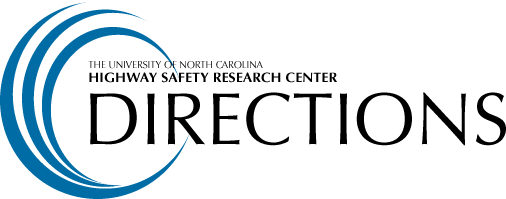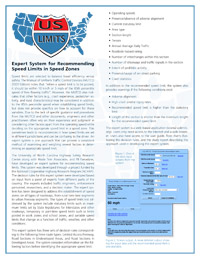

HSRC project develops an expert system for speed management

Speed limits are set to allow for efficient and safe travel on roadways of all types. The determination of a speed limit on a given roadway is not always based on a scientific formula — rather, engineers and other practitioners rely on experience and judgment in considering speed limits. The Manual of Uniform Traffic Control Devices (MUTCD) cites the use of the "85th percentile" speed for establishing the limit, which is the speed at or below which 85 percent of motorists drive on any given road. This value is based on the premise that the majority of drivers will travel at a safe and reasonable speed. At the same time, the MUTCD and other guides indicate the need to consider other factors in addition to the 85th percentile speed, such as roadway alignment, roadside characteristics, pedestrian activity and crash experience. These elements vary tremendously from one road class to another and from rural to urban environments.
It is important to identify a consistent method for setting speed limits, while taking into account all of the potential factors that may influence speed choice on any given roadway. The University of North Carolina Highway Safety Research Center, along with Wade Trim Associates and PB Farradyne, has developed a Web-based expert system for identifying reasonable and consistent speed limits across a variety of road types called USLIMITS.
"This system is unique in that it is based on knowledge derived from experts only in this country," said Raghavan Srinivasan, lead researcher. We hope that it will be used by practitioners as a tool to help them identify the appropriate speed limit for a speed zone."
Through funding from the National Cooperative Highway Safety Research Program (NCHRP), a panel of experts in highway safety and law enforcement gathered to decide upon a set of rules to follow when determining the speed limit on various types of highways, from rural two-lane roads to urban freeways. One of the goals of this system is to help promote consistency nationwide with respect to how speed limits are established, in the same way the MUTCD provides consistency across the country for traffic signs, markings and signals.
This system takes a comprehensive approach by using decision rules derived from expert knowledge for three types of highways: limited access freeways, roadways in undeveloped areas and roadways in developed areas. Prior to identifying an appropriate speed limit, the system takes into account several factors input by the user, including:
- operating speeds
- terrain
- extent of pedestrian/bike and parking activity (in developed areas)
- number of Interchanges (on freeways)
- number of driveways and traffic signals (in developed areas)
- presence of roadside hazards (in undeveloped areas)
- crash statistics and traffic volume
Some types of speed limits are not addressed by this system — statutory limits such as maximum limits established by State legislatures for certain road categories, temporary or part-time speeds limits (work zones, school zones) and variable speed limits that change with traffic, weather and other conditions.
The expert system can be utilized by anyone who has access to a Web browser. Users of the site have access to the user guide, flow charts that illustrate the decision rules and the study report describing the approach used in developing the system.
To view the final report, "An Expert System for Recommending Speed Limits in Speed Zones", published in the May 2007 edition of the Research Results Digest 318, please visit http://onlinepubs.trb.org/onlinepubs/nchrp/nchrp_rrd_318.pdf
To access the USLIMITS system, or to learn more about the development of the system, please visit www2.uslimits.org.
The University of North Carolina Highway Safety Research Center
730 Martin Luther King Jr. Blvd, Suite 300 | Campus
Box 3430 | Chapel Hill, NC 27599-3430
Phone: 919.962.2203 | Fax: 919.962.8710
http://www.hsrc.unc.edu